Check out my custom vibration dampener
10+ Best Tennis Shoes for 2024
Playtested & Reviewed
We hope you love this article. Just so you know, TennisCompanion may collect a small share of sales from the links on this page to help keep this site running. Learn more.
Tennis shoes are a vital part of your equipment that protect your feet, prevent injury, and help ensure you perform your best, so it pays to research and invest wisely.
Unfortunately, testing shoes isn’t easy or practical, so tracking down a pair you’ll love can be challenging.
To help, I’ve narrowed down, playtested, and reviewed my picks for the best tennis shoes to provide insight into their performance that you can use to inform your research and decision.
Along with valuable tips and practical advice, this guide will cover everything you need to confidently select a pair of shoes that’ll help enhance your movement so you can play your best.
Here are my top 3 picks for men and women as a sneak preview.
Men
Women
Click here to check out the full list of shoes that make the cut.
Article Contents
Click below to jump to a section
Tap below to jump to a section
The Shoe I’m Using Now
Tennis Shoe Anatomy
Finding the Perfect Fit
Shoe Buying Considerations
Shoes & Court Surfaces
Breaking Shoes In
Socks for Your Shoes
10+ Best Men’s Shoes
10+ Best Women’s Shoes
The Shoe I’m Using Now
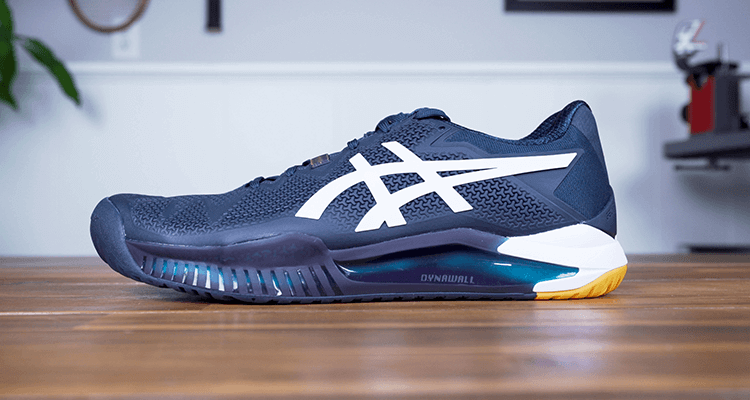
Before we dive too deep and cover my picks for the best tennis shoes, I thought I’d share what shoes I’m currently using.
Not only is it a question TennisCompanion members and readers frequently ask me, but it’s helpful to help underscore that the best shoes are unique to each individual, despite how I or any other website ranks tennis shoes.

My go-to pair of tennis shoes is the Asics Gel Resolution, which I have ranked as the third-best shoe overall. Let me explain.
At 39 going on 40, I’ve been wearing the Gel Resolution shoes primarily because of comfort, which I place a premium on these days. Beyond that, they’re incredibly well-rounded, so it’s an ideal match for me.

I prefer the low-to-the-ground feel and overall performance of a shoe like the Nike Vapor Pro, and if I were back in college competing, they’d be my top pick despite the lower durability.
However, the Vapor Pros are more demanding on my body, and I feel the effects of using them more than I used to, so I’ve prioritized comfort.

If you’re wondering why I don’t use the Asics Court FF since they top my list and outperform the Gel Resolutions in a few areas, it’s two-fold. First, I prefer the overall feel of the Gel Resolution, which rides a bit lower to the ground. Second, I like the style of the Gel Resolution and find the Court FF to look a bit bulky.
With all that said, I wanted to touch on this before diving too deep as a reminder to keep your priorities top of mind. Each shoe in this guide has unique attributes, so I’m sure you’ll find something you love.
Tennis Shoe Anatomy

Throughout this guide, I’ll refer to the different parts of a shoe, so let’s quickly review the core elements before diving too deep.
Outsole
The outermost layer of rubber at the bottom of a tennis shoe provides lasting durability and traction. Some players prefer their shoes to have a rock-solid grip, while others prefer a bit of give when stopping or sliding.
Midsole
The midsole is the thickest part of a shoe’s sole and a primary source of comfort. It sits between the outsole and the insole. Thinner midsoles keep players close to the ground for a more responsive ride, while thicker midsoles reduce shock.
Insole
The insole is the top layer of a shoe’s sole that resides above the midsole to provide a cushion and protect your foot from the stitching that attaches a shoe’s upper to the sole.
In most shoes, the insole is removable. Insoles come in varying thicknesses; some do better at wicking away sweat than others.
Shank
The shank is a rigid piece of material added toward the center of a shoe’s midsole to provide stability and prevent twisting. Some are visible at the bottom of the shoe, while others hide in the midsole. It’s worth noting that not all shoes have shanks.
Upper
A tennis shoe’s upper is the material covering or wrapping a player’s foot, which attaches to the sole to form the shoe. Most of a shoe’s ventilation comes from the upper’s material and construction.
Tongue
The material below the laces for added comfort is called the tongue. Many shoes opt for a bootie or sock design without a distinct tongue. However, the purpose of that section remains the same.
Eyelets
The laces of a shoe go through the eyelets, allowing players to lace and tighten their shoe for support and stability. Weak or sub-par eyelets can break, making it impossible to tie the shoe properly.
Collar
The collar sits at the back of the shoe and is a layer of cushion that wraps around your ankle to help keep your foot in place and protect your heel from the heel counter while adding comfort.
Heel Counter
You’ll find the heel counter at the back of a shoe – a stiffer material that reinforces the heel and adds stability. Usually, you can’t see a shoe’s heel counter because manufacturers weave them into the shoe’s upper.
Toe Guard
The toe guard is the portion of a shoe’s outsole that extends up the front of your toes to provide protection and added durability for this high-impact zone. Some lightweight tennis shoes provide limited toe guards.
Toe Cap
The toe cap sits above the toe guard and extends to the sides at the front of a tennis shoe, providing added protection and stability for the shoe’s front. Materials and durability will vary, and some shoes don’t have them.
Toe Box
The shoe section surrounding a player’s toes is the toe box. The toe cap sits outside the toe box at the front of the shoe. Players who have wider feet will usually prefer a wider toe box.
Although this isn’t an exhaustive list of the different parts of a tennis shoe, it should provide you with the critical elements to keep an eye on when purchasing your next pair.
Hopefully, it’s a helpful reference as I discuss them in this guide.
Finding The Perfect Fit
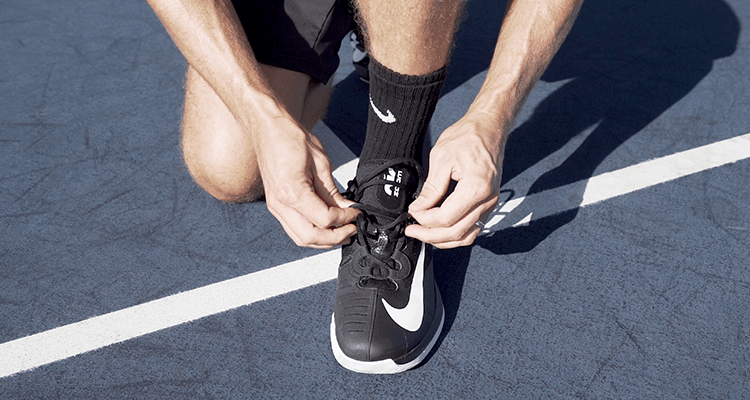
Hands down, the most important thing to get right when purchasing a new pair of tennis shoes is the fit. Let’s walk through a few different topics to keep in mind when evaluating shoes.
Size
Your shoe size is perhaps the most obvious when it comes to achieving the right fit. Are you confident in your size?
Ideally, you’ll have roughly a half-inch or 13 millimeters between the tip of your big toe and the front of your shoe. A quick test that works reasonably well is to use your thumb’s width to check this space.
Adequate room at the front of your shoe helps avoid jamming your toes and prevents blisters, allowing them to breathe and stay cool.
On the other hand, tennis shoes that are too large can also lead to excessive movement of your foot, which can cause blisters and issues with your calf muscles and Achilles.
Helpful Tip
It’s common for people to have different size feet. If that’s you, you’ll want to use your larger foot as the basis for measuring space at the front of your toes to ensure you have enough room.Also, keep in mind that not all shoes run true to size, so you may need to adjust what you typically buy, especially when switching brands.
Width
For a large portion of the world’s population, standard or regular-width shoes do the trick, but if you fall outside of this range, it’s crucial to find the correct width for the health of your feet.
The systems denoting a shoe’s width vary internationally, but you can look at the most common North American system below.
| Width | Men | Women |
| A | Narrow | |
| B | Standard | |
| C | Narrow | Wide |
| D | Standard | |
| E | Wide | |
| EE | ||
| EEE | ||
| EEEE | ||
| F | ||
| G |
You’ll find the majority of men’s tennis shoes are standard width, with some wide and extra-wide available.
On the women’s side, you’ll find a few shoes that run narrow, but the majority are standard width with a decent selection that is wide.
Toe Box
The available space for your toes in a shoe will correlate with the width of the shoe. However, since most shoes are standard size, you’ll find that some have tighter or more roomy toe boxes.
If you’ve found the front of your foot and toes to feel a little cramped in the past, keep your eyes peeled for options that offer extra room toward the front of the shoe, or consider measuring your feet to see if you’re a candidate for a wider shoe.
For example, it’s common for adidas tennis shoes to have a little extra room in the toe box.
Ankles
Although this isn’t typically a problem for most, some may find that the bones at the outer edge of their ankles (fibula and tibia) contact their shoe’s upper edge and cause discomfort.
When you first try on a shoe, it’s worth watching out for any rubbing around your ankles, which playing tennis will amplify and may lead to discomfort.
Heel
An appropriately sized shoe should prevent most players’ heels from lifting out of their shoes, but some models emphasize the design at the heel to keep your foot locked in place.
If you’re dealing with a shoe that doesn’t provide enough heel support, you may want to pay closer attention to this feature. Of course, getting the size right is crucial as well.
Shoe Buying Considerations

If you’ve ever found yourself stuck with a new pair of shoes that felt good out of the box but didn’t meet your expectations after hitting the court, then you know how frustrating it can be.
Unfortunately, tracking down the perfect set of shoes can be challenging, and more often than not, we make tradeoffs.
In this section, I’ll run through some key attributes you can use to help evaluate your next set of shoes.
It’s helpful to nail down the most critical two or three before you begin your search because it helps narrow your options.
Comfort
By nature, tennis shoes tend to be stiffer than many others because they need to support a wide range of motion, including the lateral movements essential when hitting the court.
Despite that, some tennis shoes emphasize comfort more than others. Typically, you’ll want to look for shoes with a generous midsole. However, the insole can also provide added support, which you may consider replacing if it’s removable for extra comfort.
Stability
When playing tennis, sharp or abrupt movements are common. Whether you’re moving side to side, hitting groundstrokes, coming forward and approaching the net to volley, or moving back to track down a lob, your shoes must provide adequate stability.
The stability of a shoe can come from a few different places. For example, the width of a shoe’s sole can provide a platform for balance, which allows the shoe to feel stable.
Furthermore, the sole of a shoe needs to have enough rigidity to handle the quick stop-and-start movements around the court. To that end, many shoes will use a rigid plastic insert called a shank toward the middle of their sole to increase stability and prevent twisting.
Last but not least, a shoe’s upper is often associated with stability, particularly at the ankle, but also with how secure your foot feels wrapped in the shoe. Ideally, you want your foot to feel locked in place so it’s not sliding forward as you start and stop.
As a result, a shoe’s lacing system also plays a role in stability.
Durability
Most tennis players enjoy the sport on hard courts, so shoes must be durable enough to stand up to the beating they take.
One of the most critical components of a shoe’s durability comes from the outsole at the shoe’s bottom, which is in constant contact with the court. However, it’s not the only part of the shoe that must be durable.
The toe of a tennis shoe also frequently comes in contact with the court, and the forward upper section of the shoe can scrape the court periodically during a slide or lunge.
Different styles of play can lead to wear in specific shoe areas, and every player has distinct movements that can also lead to unexpected wear. For example, some players drag their feet when serving and may require a more durable toe cap for their shoes to last.
Before buying your next pair of tennis shoes, it can be helpful to inspect your current shoes to see which areas need extra protection, and then keep that in mind as you evaluate shoes.
Weight
The weight of a tennis shoe is a feature that many players associate with speed. A lightweight shoe feels fast for most players, while a heavier shoe may feel sluggish.
Shoe manufacturers often trade weight, stability, and durability to strike an appealing balance. If you remove material from a shoe, it will become lighter, but there is usually a sacrifice in the shoe’s stability or durability.
It’s worth keeping in mind that as the size of the shoe changes, so does the weight, which is one factor to keep in mind as you consider moving up or down a size to achieve the ideal fit.
The adidas Adizero Ubersonic 4 is an example of a lightweight shoe that’s popular for both men and women.
Arch Support
Different shoes come with varying levels of arch support, which can help alleviate pain, but most feature moderate to low-end arch support to appeal to the broadest range of players.
However, if additional arch support is needed, it’s common for players to replace the insole of their tennis shoes with a custom insert.
Ventilation
Depending on the climate you play in, ventilation may be more or less of a priority. Proper ventilation can help keep your feet dry and prevent blisters in hot weather.
Also, keep in mind that your shoe’s color will play a role in how hot your feet get. Light colors reflect the sun’s heat, and darker colors absorb it, which will cause your feet to get warmer.
The adidas adizero Cybersonic is an excellent example of a shoe that prioritizes ventilation and keeps weight down.
Helpful Tip
The type of socks you wear can affect how cool and dry your feet stay, so it’s worth considering the socks you wear. Plus, you can always bring a change of socks to swap out during a match.
Traction
The outsole of a tennis shoe is directly responsible for the traction a shoe offers. Many players appreciate shoes that offer excellent grip on hard courts while providing a bit of give when stopping to slide.
The outsole’s material, texture, and pattern contribute to the traction a player will feel when moving around the court. Of course, the court surface makes a huge difference as well.
For example, clay court tennis shoes use a herringbone tread or pattern throughout the bottom of a shoe, which helps clay release naturally during movement on the court while also providing consistency or predictability in slides.
Level of Play
Generally, the more expensive a tennis shoe, the more features it will offer that cater to an advanced player’s needs.
As a result, beginners may opt for less expensive tennis shoes that provide reliable performance but don’t have all the bells and whistles.
Ultimately, it’s a preference, and springing for a high-end pair is fine, but newer players will typically put less stress on their shoes, so you may find the premium features overkill.
It’s a similar recommendation I make for players buying a beginner tennis racquet.
Price
Last but certainly not least, price is a significant consideration when evaluating or purchasing a new pair of tennis shoes.
Setting a budget before shopping for shoes is a great way to narrow your options. You don’t need to overspend to find a quality tennis shoe, as many affordable models offer excellent performance.
If you’re looking to save money, it’s best to avoid buying the latest and greatest shoes when they come out at their highest price. Instead, waiting a season or purchasing last year’s model is a great way to save.
Helpful Tip
Another great reason to wait a season before buying a newer model shoe is to see how they fair with other tennis players. Purchasing shoes that have received positive reviews from hundreds of customers will help you make a confident purchase.
Shoes & Court Surfaces

Although most of us play tennis on hard courts, it’s worth noting that different shoes are available for various surfaces.
If a shoe doesn’t call out a specific court type in the description, it’s safe to assume it will perform well on hard courts.
Hard Courts
Tennis shoes for hard courts emphasize comfort and durability to stand up to the unforgiving surface. They also feature non-marking soles that protect the court from unsightly scuff marks.
Most tennis shoes feature design characteristics well-suited for hard courts because they’re the most popular surface.
Furthermore, hard court tennis shoes can be used on clay and grass courts, although a specialized design is ideal, as we’ll cover next.
Clay Courts
Clay court tennis shoes have a few unique features that help maximize their performance on this surface.
First and foremost, these shoes typically feature a herringbone tread pattern throughout the outsole to provide grip on the slick surface. However, this tread pattern is also beneficial because it helps release clay efficiently, ensuring the shoe maintains traction.
Furthermore, clay court shoes don’t require as much cushioning or stability via the sole, so you’ll find design tweaks taking that into consideration, which often helps them shed some weight.
On a more subtle note, clay court tennis shoes use mesh sparingly or feature tighter mesh than their hardcourt counterparts to prevent clay from entering the shoe’s upper.
Grass Courts
These days, grass courts are in the minority for court surfaces, but if you’re lucky enough to spend time on this surface regularly, there are a few design characteristics to keep in mind.
Most notably, grass courts are slick, so tennis players use shoes with flatter soles covered with tiny studs or pimples to maximize traction.
Of course, they must be subtle to avoid damage to the courts, and clubs like Wimbledon have stringent rules regarding this design.
Unfortunately, grass court tennis shoes with studded designs are hard to come by due to low demand.
Breaking Shoes In
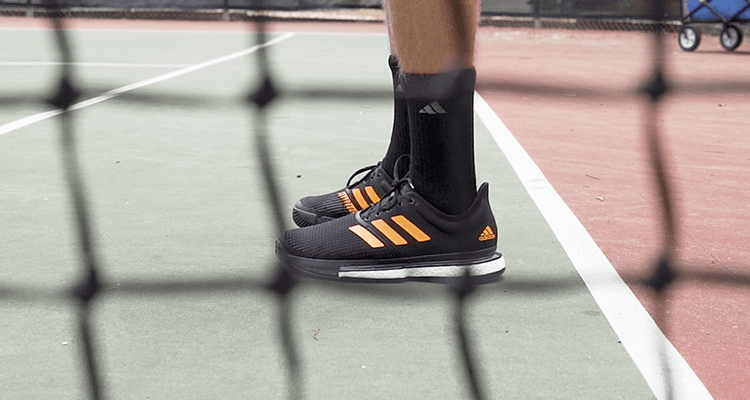
Break-in refers to whether or not a shoe will cause some discomfort if a player wears their new shoes for an extended period and aggressive play right out of the box.
These days, most tennis shoes don’t require a break-in period for comfort, but some players find exercising caution with a new pair of shoes helpful to avoid unintended consequences like a nagging blister.
To break in a new pair of tennis shoes, you can wear them casually off-court for a few days or a few shorter practices so that the shoe’s materials loosen up and become more forgiving.
If a shoe is causing discomfort after a few practices, its design may not be well suited for your feet.
Don’t Forget About the Socks
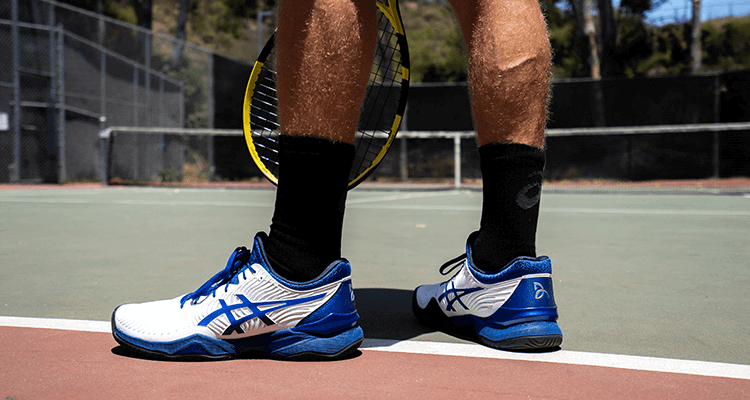
Often overlooked, tennis socks can make or break a player’s comfort and reduce the likelihood of blisters.
Athletic varieties are usually more durable than your average socks, providing added cushion and wicking sweat.
Companies use a variety of materials to create socks for tennis – here are a few that are common:
- Cotton
- Polyester
- Nylon
- Acrylic
- Lycra
- Spandex
- Teflon
- Profilen
- Olefin
When buying a pair of socks, consider the materials as a factor for gauging the type of performance they’ll offer.
If comfort is a priority, look for socks with added padding in the toes, forefoot, arches, and heels. You may also appreciate moisture control and breathable socks to help keep your feet dry.
Ultimately, there’s no right or wrong answer to which socks are best for players, but they’re worth your consideration.
10+ Best Men’s Tennis Shoes
To help simplify finding a great pair of kicks, I’ve narrowed down and reviewed my picks for the ten best men’s tennis shoes for 2024.
For quick reference, here’s a snapshot and comparison of each shoe. Keep scrolling to review the details for each.
| Men’s Tennis Shoes | Comfort | Stability | Durability | Traction | Ventilation | Average |
| Asics Court FF 3 | 9.4 | 9.3 | 9.1 | 9.0 | 8.4 | 9.04 |
| Nike Vapor Pro 2 | 8.9 | 8.7 | 8.5 | 9.0 | 9.4 | 8.90 |
| Asics Gel Resolution 9 | 9.3 | 8.9 | 9.0 | 9.0 | 8.2 | 8.88 |
| KSwiss HyperCourt Express 2 | 8.9 | 8.9 | 8.9 | 8.7 | 8.5 | 8.78 |
| Asics Solution Speed FF 2 | 9.1 | 8.7 | 8.7 | 8.7 | 8.4 | 8.72 |
| Nike Zoom Vapor 11 | 8.6 | 8.9 | 7.9 | 8.9 | 9.2 | 8.70 |
| adidas adizero Ubersonic 4 | 8.7 | 8.7 | 8.5 | 8.7 | 8.8 | 8.68 |
| New Balance 996 v5 | 8.7 | 8.6 | 8.4 | 8.8 | 8.7 | 8.64 |
| adidas adizero Cybersonic | 8.5 | 8.6 | 8.4 | 8.7 | 8.8 | 8.60 |
| Fila Axilus 2.5 Energized | 8.5 | 8.6 | 8.6 | 8.6 | 8.6 | 8.58 |
| New Balance Lav v2 | 8.7 | 8.6 | 8.3 | 8.6 | 8.7 | 8.58 |
| adidas Barricade | 8.2 | 8.8 | 8.8 | 8.8 | 8.3 | 8.58 |
| Nike Air Zoom Vapor Cage 4 | 8.5 | 8.7 | 8.7 | 8.7 | 8.3 | 8.58 |
| Nike React Vapor NXT | 8.3 | 8.3 | 8.7 | 8.8 | 8.5 | 8.52 |
| Babolat Jet Mach III | 8.5 | 8.4 | 8.6 | 8.6 | 8.4 | 8.50 |
Asics Court FF 3

The best men’s tennis shoe for 2024 is the Asics Court FF, which does pretty much everything well. It’s also the shoe of choice for Novak Djokovic, one of the greatest tennis players ever.
The shoe’s outsole features Asics’ extra-durable AHAR+ rubber outsole, offering plenty of traction with a unique herringbone-like tread pattern that works particularly well on hard courts.
The outsole also provides extra protection higher up on familiar wear areas on the inside of your foot, which I appreciate.
At the midsole, the Court FF 2 features Asics proprietary FlyteFoam, which offers exceptional comfort and provides 76 percent better cushioning while being 55 percent lighter than standard EVA foam. Add to that Asics’ Gel Technology for shock absorption, and you have one of the most comfortable shoes available.
The upper continues the shoe’s excellence with a super comfortable bootie design that is near perfect. I’d have no complaints if it provided more breathability and flexibility, but it’s pretty good.
Overall, the Asics Court FF 3 is a premium tennis shoe that will undoubtedly remain one of the top shoes for the foreseeable future.
Why I Love Them
- Comfort
- Stability
Area for Improvement
- Ventilation
Top Players Using
- Novak Djokovic
- Borna Coric
Specs
| Size | True |
| Width | Medium |
| Arch Support | Medium |
| Weight | 15.3 ounces @ size 10.5 |
| Colors | Black/Hot Pink White/Black Steel Blue/White Tuna Blue/White |
Ratings
Nike Vapor Pro 2

Released alongside the Vapor 11, the Nike Vapor Pro 2 is a follow-up to the Nike Air Zoom Vapor Pro. However, it’s a unique release in that Nike has increased the shoe’s weight, opting for extra comfort, one of the most significant downsides to the prior model.
For the outsole, you’ll find a modified herringbone-style tread that sheds weight in low-wear areas and delivers an excellent balance between grip for traction and give for sliding, which helps prevent your foot from locking up during hard stops.
Like the Vapor 11, the Vapor Pro 2 also features a single zoom air unit in the forefoot for shock absorption while retaining a low-to-the-ground feel and a full-length EVA foam midsole for comfort.
Nike constructs the upper with durable mesh for breathability. Asymmetrical lacing provides added support, and a stretchy internal sleeve hugs your foot for a sock-like fit.
Compared to the Vapor 11s, the Vapor Pro 2 is lighter, weighing 8% less or 1.2 ounces lighter in a men’s size 10.5. The Vapor Pro 2 also features a durable rubber toe cap that runs through to the medial or inside edge of the shoe for added protection with toe drags. The Vapor 11, on the other hand, will offer more stability during side-to-side movement.
Why I Love Them
- Comfort
- Stability
Area for Improvement
- Durability
Top Players Using
- Karen Khachanov
- Holger Rune
Specs
| Size | True |
| Width | Medium |
| Arch Support | Slightly Low |
| Weight | 14.3 ounces @ size 10.5 |
| Colors | Black/White White/Black White/Fuchsia/Red |
Ratings
Asics Gel Resolution 9

The Gel Resolution series of tennis shoes has been one of Asics’ most popular, and their release of the Gel Resolution 9 continues the trend as one of my favorites, delivering excellent all-around performance.
The shoe’s outsole features Asics’ durable AHAR+ rubber material used in a wide range of their footwear to provide plenty of traction and twice as much durability as standard rubber.
One of my favorite parts about these shoes is the gel midsole, which combines with Asics FlyteFoam to provide exceptional comfort and shock absorption as a standout feature that’s a cut above the rest.
For stability, the Gel Resolution incorporates their Dynawall technology on the outside or lateral portion of the shoe. However, Asics has taken this a step further, wrapping it around the heel and through the inside.
Beyond that, the Asics Gel Resolution 9’s upper offers snug comfort and stability around your foot with its Flexion Fit design. If you’re coming from the Asics Gel Resolution 8, you’ll be pleased with this update.
Why I Love Them
- Durability
- Comfort
Area for Improvement
- Ventilation
Top Players Using
- Gaël Monfils
- Marin Cilic
- Pablo Cuevas
Specs
| Size | True |
| Width | Medium |
| Arch Support | Medium |
| Weight | 15 ounces @ size 10.5 |
| Colors | White/Black Steel Blue/Green Black/Blue |
Ratings
K-Swiss Hypercourt Express 2

The Hypercourt Express 2 is a premium tennis shoe from K-Swiss that delivers lightweight comfort, durability, and stability.
The outsole of this tennis shoe uses Aosta 7.0, a high-density rubber compound that’s extra durable and offers reliable traction.
In the shoe’s midsole, you’ll find Surglite for lightweight comfort combined with a midfoot TPU shank to prevent twisting and aid stability.
K-Swiss tops off the Hypercourt Express 2 with DuraWrap Flex for protective comfort and support that’s more flexible than the previous generation, an Ortholite liner for moisture control, and added cushion.
Why I Love Them
- Lightweight comfort
- Stability
Area for Improvement
- Ventilation
Specs
| Size | True |
| Width | Slightly Wide |
| Arch Support | Slightly Low |
| Weight | 13.0 ounces @ size 10.5 |
| Colors | White/Blue White/Blue Opal Vapor/Peacoat Pond/White White/Black White/Primerose Blue/White Black/White Barely Blue Black/Orange |
Ratings
Asics Solution Speed FF 2
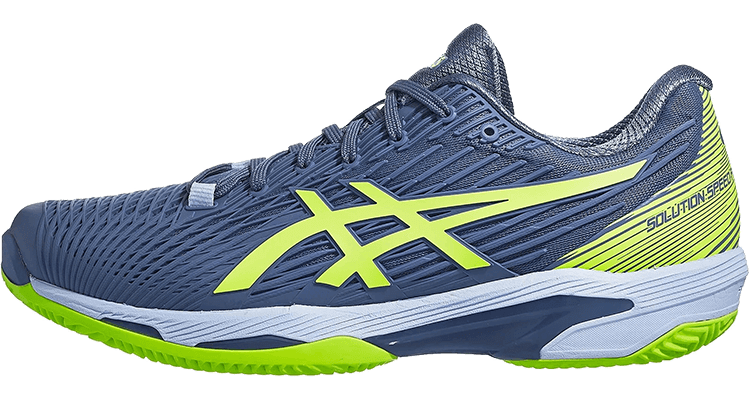
The Asics Solution Speed FF 2 is an ultra-light tennis shoe that offers premium comfort and performance on the court.
The shoe’s outsole is AHAR rubber, the same material you’ll find on the Court FF 3 and the Gel Resolution 9, and it comes with a herringbone tread for maximum traction that works on hard and clay courts.
At the midsole, you’ll find FlyteFoam, lightweight EVA foam that makes for a super comfortable ride, and their Gel technology in the heel to absorb shock. A Twisstrust suspension system at the shoe’s center helps prevent twisting and maintain stability.
The upper for the Asics Solution Speed FF 2 offers comfort and support with a redesign to its Flexion Fit technology for added flexibility while maintaining abrasion resistance. Finally, the shoe’s Ortholite insole will help keep your feet dry and add to the shoe’s cushion.
Why I Love Them
- Lightweight Comfort
- Traction
Area for Improvement
- Ventilation
Top Players Using
- David Goffin
- Alex De Minaur
- Vasek Pospisil
Specs
| Size | True |
| Width | Medium |
| Arch Support | Medium |
| Weight | 12.9 ounces @ size 10.5 |
| Colors | Steel Blue/Green White/Black |
Ratings
Nike Zoom Vapor 11
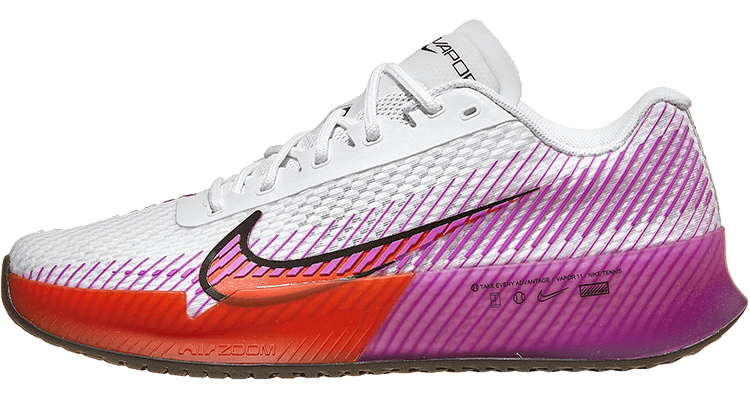
One of the latest editions to their tennis shoe lineup, the Nike Zoom Vapor 11, picks up where the Vapor X left off with a low-to-the-ground feel but provides significantly more cushion underfoot than its predecessor for added comfort.
The outsole offers durable rubber, which takes advantage of Nike’s unique approach to removing excess material in low-wear areas to reduce the shoe’s weight without negatively impacting durability.
For the midsole, Vapor 11 uses EVA throughout the length of the shoe, which is thinner in the front and thicker in the back. However, you’ll find an integrated zoom air unit toward the front of the shoe for added comfort and shock absorption. As a result, Nike retains a low-to-the-ground feel while increasing cushion for heel strikes.
For added stability, the Nike Zoom Vapor 11 also features a foot frame that wraps the outer or lateral portion of the shoe around the heel.
The shoe’s upper uses reinforced mesh for support and breathability topped off with some added TPU protection, adding to the shoe’s styling. Finally, a half inner sleeve helps make it easier to put the shoes on.
Why I Love Them
- Stability
- Traction
Area for Improvement
- Durability
Top Players Using
- Carlos Alcaraz
- Nick Kyrgios
- Andrey Rublev
Specs
| Size | True |
| Width | Slightly Small |
| Arch Support | Slightly Narrow |
| Weight | 15.5 ounces @ size 10.5 |
| Colors | Black/White White/Black White/Fuchsia/Red |
Ratings
adidas Adizero Ubersonic 4

Another lightweight tennis shoe I love is the adidas Adizero Ubersonic 4, which performs exceptionally well across the board.
The outsole features a durable herringbone tread design that’s denser on the inside or medial portion for added durability and more spread apart on the outside for easier sliding. As a result, this tread is now best suited for hard courts.
For the midsole, adidas introduces Lightstrike, a responsive and lightweight compound that delivers comfort while retaining excellent response for quick movement.
adidas’ Primeknit upper uses a breathable mesh bootie construction that’s super comfortable. Over the top, you’ll find a protective layer of Primegreen material that provides abrasion resistance and added stability, which combines with Adituff panels in high-wear areas for extra durability.
Why I Love Them
- Comfort
- Weight
Area for Improvement
- Durability
Top Players Using
- Alexander Zverev
- Fernando Verdasco
- Lucas Pouille
- Gilles Simon
- Ernests Gulbis
- Mischa Zverev
Specs
| Size | True |
| Width | Wider in front |
| Arch Support | Medium |
| Weight | 13.5 ounces @ size 10.5 |
| Colors | White/Blue White/Taupe/Orange Red/Blue Grey/Blue/Black White/Silver/Lilac Black/Silver/Red Red/White Green/Solar Green Black/Green White/Blue White/Mint/Turbo White/Black/Silver Black/Blue |
Ratings
New Balance 996 v5

At 12.4 ounces in size 10.5, the 996 v5 is New Balance’s flagship lightweight tennis shoe, one of the lightest options on the market.
Starting with the outsole, you’ll find New Balance’s NDurance rubber for excellent traction and durability. For its tread, you’ll find a wave-style pattern well-suited for hard courts, delivering a grip that doesn’t lock up for players who like to be able to slide.
Moving up to the midsole, you’ll find FuelCell EVA foam that’s lightweight and highly responsive, with a 55% rebound as you move.
Finally, the upper’s Hypoknit construction is a crucial ingredient that helps the shoe maintain low weight and excellent breathability.
As with many lightweight offerings, the 996 v5 sheds material to keep the weight low. As a result, these shoes aren’t the most supportive, and the less pronounced toe guard lacks a bit of durability. However, the latest update does incorporate NDure into their upper for abrasion resistance above the toe guard and on the inside or medial edge.
Why I Love Them
- Lightweight Comfort
- Traction
Area for Improvement
- Durability
Specs
| Size | True |
| Width | Coming Soon |
| Arch Support | Coming Soon |
| Weight | Coming Soon @ size 10.5 |
| Colors | Dragonfly/Black Red/Lapis |
Ratings
adidas adizero Cybersonic
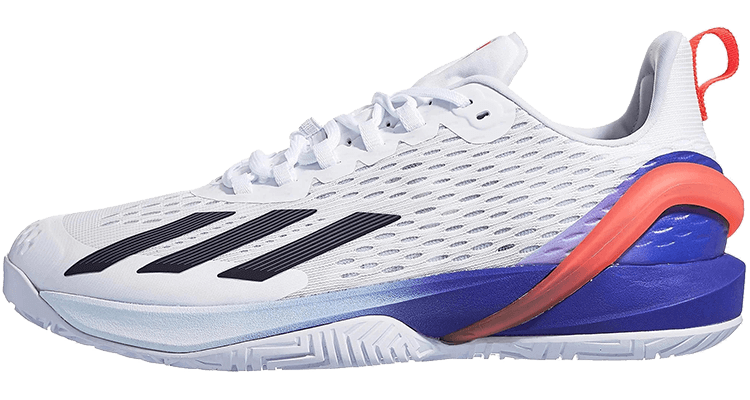
Built from the ground up for speed, the adizero Cybersonic is the latest addition to the adidas tennis footwear lineup.
The shoe’s outsole uses an ultra-reliable adiwear rubber with a unique multidirectional tread pattern ideal for hard courts that provides enough give to allow players to slide when making an abrupt stop.
For the midsole, you’ll find Lightstrike foam for responsive comfort that is lighter than traditional EVA foams to reduce weight. For more efficient movement and change of direction, the Cybersonic integrates Energyrods, which help enhance stability and improve acceleration.
The shoe’s upper consists of breathable mesh and a stretchy internal sleeve connecting to the tongue for added comfort. Finally, an outer layer of adituff serves as a protective toe cap for food drags.
Why I Love Them
- Traction
- Stability
Area for Improvement
- Durability
Specs
| Size | True |
| Width | Medium |
| Arch Support | Medium |
| Weight | 14.1 ounces @ size 10.5 |
| Colors | White/Blue/Red |
Ratings
Fila Axilus 2.5 Energized

The Fila Axilus 2.5 is a sleeper when it comes to quality tennis shoes, but it’s a well-rounded option that’s lightweight and wraps my list of the best men’s tennis shoes.
The outsole features a two-piece durable EverGrind rubber with a familiar tread pattern for traction on various court surfaces.
You’ll find Fila’s latest Energized Rubber at the shoe’s midsole for added comfort and energy return with each step. The shoe incorporates a midfoot TPU shank for stability, which helps prevent twisting.
The shoe’s upper provides ventilation through its breathable mesh, while the Molded Cage at the front provides protection and added stability. Inside the shoe, you’ll also benefit from anti-slip nylon to help keep your foot securely in place.
Why I Love Them
- Stability
- Durability
Area for Improvement
- Comfort
Top Players Using
- Andreas Seppi
- Diego Schwartzman
- John Isner
- Sam Querrey
- Reilly Opelka
Specs
| Size | True |
| Width | Slightly wide |
| Arch Support | Low |
| Weight | 13.7 ounces @ size 10.5 |
| Colors | White/Navy/Red White/White Black/Purple |
Ratings
New Balance Lav v2

One of my favorite shoes from the New Balance line is the Lav, which Milos Raonic and Tommy Paul endorse.
The Lav’s outsole features NDurance rubber, which helps provide maximum durability and traction on the court.
At the midsole, the shoes get upgraded with Fresh FoamX, an update to the original Fresh Foam that optimizes the shoe for heel comfort and forefoot stability.
For the upper, you’ll find NDure tech for extra durability and a synthetic mesh dubbed FitWeave for responsive yet stable comfort.
The Lav 2 also incorporates a visible heel counter for extra stability at the shoe’s heel. A prominent toe cap is present at the front for added durability, especially during toe drags.
Why I Love Them
- Comfort
- Stability
Area for Improvement
- Durability
Top Players Using
- Milos Raonic
- Reilly Opelka
- Tommy Paul
Specs
| Size | True |
| Width | Medium |
| Arch Support | Medium |
| Weight | 14.3 ounces @ size 10.5 |
| Colors | Blue/Purple Orange/Grey Red/Egg Yolk Night Sky |
Ratings
adidas Barricade
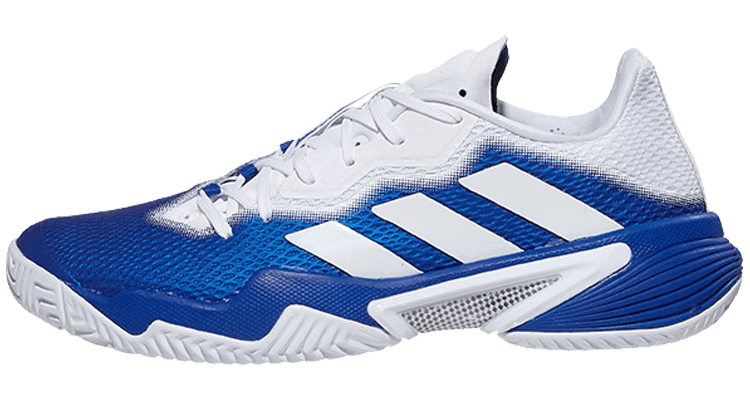
In 2021, tennis fans worldwide were treated to the return of the iconic Barricade shoe, which Adidas suspended production of in 2018, allowing their team to take a step back on the design.
Known for its durability, stability, and striking silhouette, the 12th generation of the shoe is a modern take on a classic, rebuilt from the ground up to incorporate new technologies while staying true to its roots.
For the outsole, the Barricade uses an Adiwear rubber compound with a herringbone-style tread that’s thicker on the inside for added durability and easier sliding while thinner on the outside for optional traction.
The shoe features Bounce 2.0 for responsive comfort at the midsole and a stabilizing mid-foot shank for confident side-to-side movement.
The Barricade’s upper includes:
- A soft neoprene tongue for comfort and breathability.
- Asymmetrical lacing for a secure and adaptive fit.
- Hidden lacing loops for protection.
- Protective RPU at the toe and inside of the shoe.
Overall, the shoe delivers excellent durability, stability, and traction but leaves room for improvement in comfort and ventilation.
Why I Love Them
- Durability
- Stability
Area for Improvement
- Comfort
Top Players Using
- Sebastian Korda
Specs
| Size | True |
| Width | True |
| Arch Support | Medium |
| Weight | 14.2 ounces @ size 10.5 |
| Colors | Black/Yellow/Blue Blue/White White/Blue/Green White Red/Black Black/White Ecru/Yellow White/Black/Solar Red Carbon/Green/Lilac Blue/Black/Red Black/Silver/Red |
Ratings
Nike Air Zoom Vapor Cage 4

Endorsed by Rafael Nadal, the Nike Air Zoom Vapor Cage 4 is one of Nike’s most durable and stable tennis shoes that doesn’t skimp on comfort.
Nike features a durable rubber compound for the outsole blended with Kurim for added protection in high-wear areas and wraps up the midsole for slide protection where needed most.
At the midsole, you’ll find a thick foam for comfort combined with a Zoom Air unit at the forefoot for added response and energy return. A hard plastic foot frame provides stability on the outside or lateral edge of the shoe’s midsole, especially during side-to-side movement.
You’ll find thick and supportive materials that offer good breathability for the upper, topped off with a specialized lacing system that hides the medial eyelets for durability while hugging your foot for maximum support.
Why I Love Them
- Stability
- Traction
Area for Improvement
- Comfort
Top Players Using
- Rafael Nadal
Specs
| Size | True |
| Width | Narrow |
| Arch Support | Medium |
| Weight | 15.6 ounces @ size 10.5 |
| Colors | White/Blue Blue/Orange Off Noir/Volt |
Ratings
Nike React Vapor NXT
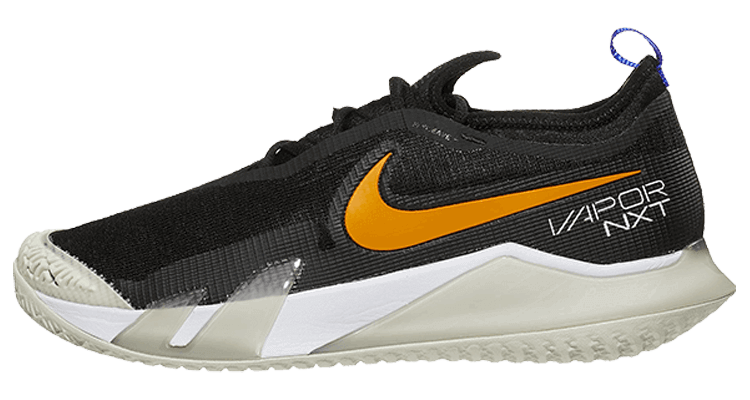
A new model released in 2021 from Nike, the React Vapor NXT is an edgy new offering that delivers solid durability and traction.
The outsole is a classic Nike offering, incorporating a data-influenced generative design for optimal protection in high-wear areas.
At the midsole, the shoe uses a surprisingly thick layer of React foam for responsive comfort toward the arch, while players will find a firmer foam on the outside edge for stability. Around the heel and outer edge, a semi-transparent foot frame wraps the shoe for extra support.
The React Vapor NXT’s upper features a comfortable bootie construction wrapped with a flexible, supportive, and breathable Flyweave layer. Finally, a thick plastic pane waps the toe and lateral side of the shoe for extra abrasion resistance and durability.
Why I Love Them
- Durability
- Traction
Area for Improvement
- Stability
Specs
| Size | True |
| Width | Medium |
| Arch Support | Medium-Low |
| Weight | 15.8 ounces @ size 10.5 |
| Colors | Black/White/Orange White/Black Blue/White Grey/White Royal Blue/White White/Orange |
Ratings
Babolat Jet Mach III

If you’re in the market for a lightweight tennis shoe that delivers solid all-around performance, then the Babolat Jet Mach III, which weighs 12.1 oz in a men’s size 10.5, is well worth checking out.
The Jet Mach III features premium Michelin DIN20 rubber for optimal durability and traction for the outsoles – ideal for hardcourts.
At the midsole, KPRS-X EVA foam delivers excellent shock absorption throughout the entire length of the shoe, with emphasis on the heel.
Babolat introduces MATRYX EVO for the upper, a technical fabric developed in partnership with Chamatex. Aramide and Polyamide fibers help provide stability and added durability against abrasion while retaining flexible comfort.
Although their weight moderately reduces the shoe’s stability and durability, they’re best-in-class for these areas relative to other lightweight shoes that suffer more noticeably.
Why I Love Them
- Durability
- Traction
Area for Improvement
- Comfort
Specs
| Size | True |
| Width | Medium |
| Arch Support | Medium |
| Weight | 12.1 ounces @ size 10.5 |
| Colors | Black/Gold Green/Purple White Blue/Red |
Ratings
10+ Best Women’s Tennis Shoes
Next up, we’re taking a look a the ten best tennis women’s tennis shoes for 2024 to help you quickly find a pair you’ll love.
For quick reference, here’s a snapshot and comparison of each shoe.
| Women’s Tennis Shoes | Comfort | Stability | Durability | Traction | Ventilation | Average |
| K-Swiss Hypercourt Express 2 | 9.0 | 9.1 | 9.1 | 8.9 | 8.5 | 8.92 |
| Nike Vapor Pro 2 | 8.9 | 8.7 | 8.5 | 9.0 | 9.4 | 8.90 |
| Wilson Rush Pro 4.0 | 8.9 | 8.9 | 8.9 | 8.8 | 8.9 | 8.88 |
| Asics Solution Speed FF 2 | 9.1 | 8.8 | 8.7 | 9.0 | 8.7 | 8.86 |
| New Balance 996 v5 | 9.1 | 8.7 | 8.6 | 9.0 | 8.8 | 8.84 |
| Asics Gel Resolution 9 | 9.2 | 8.9 | 8.9 | 8.8 | 8.4 | 8.84 |
| Nike Zoom Vapor 11 | 8.7 | 8.9 | 8.4 | 8.9 | 9.2 | 8.82 |
| Fila Axilus 2.5 Energized | 8.7 | 8.7 | 8.6 | 8.9 | 8.7 | 8.72 |
| K-Swiss Ultrashot 3 | 8.5 | 8.7 | 9.0 | 8.8 | 8.4 | 8.68 |
| adidas adizero Ubersonic 4 | 8.9 | 8.6 | 8.5 | 8.7 | 8.7 | 8.68 |
| Asics Court FF 3 | 8.5 | 8.9 | 8.9 | 9.0 | 8.1 | 8.68 |
| adidas adizero Cybersonic | 8.7 | 8.7 | 8.5 | 8.7 | 8.7 | 8.66 |
| New Balance Lav v2 | 8.8 | 8.7 | 8.5 | 8.6 | 8.7 | 8.66 |
| Babolat Jet Mach III | 8.6 | 8.6 | 8.7 | 8.9 | 8.3 | 8.62 |
| adidas Barricade | 8.3 | 8.9 | 8.9 | 8.8 | 8.2 | 8.62 |
K-Swiss Hypercourt Express 2

Updated in 2020, the Hypercourt Express 2 from K-Swiss delivers all-around performance, emphasizing comfort and durability.
Like the Ultrashot 2, this model uses Aosta 7 rubber for the outsole to deliver durability and offers a unique take on the traditional herringbone-style tread pattern for traction.
The midsole uses K-Swiss’ Surgeline technology for lightweight comfort without adding too much weight.
Finally, the upper mixes breathable synthetic mesh that helps keep your feet cool with K-Swiss DuraWrap Flex for durability and stability without giving up the flex necessary for dynamic movement.
Why I Love Them
- Stability
- Durability
Area for Improvement
- Ventilation
Specs
| Size | True |
| Width | Medium |
| Arch Support | Low |
| Weight | 10.8 ounces @ size 8.5 |
| Colors | White/Blue Vapor/White Blue/Pink Pink/Grape White/Blue/Lilac White/Black Blue/White Black/White White/Black Barely Blue |
Ratings
Nike Vapor Pro 2
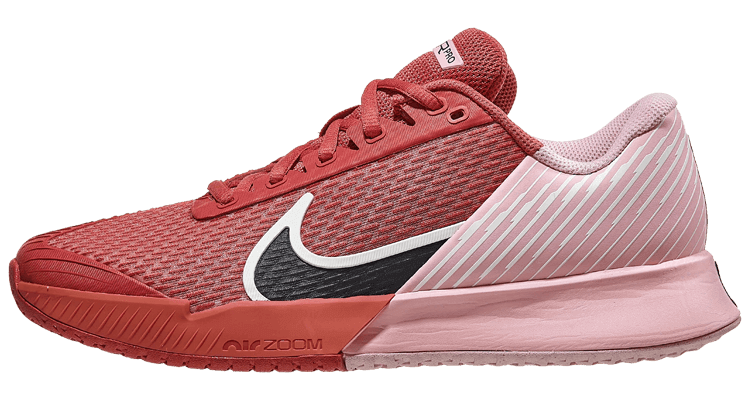
The Nike Vapor Pro 2 remains one of the most popular tennis shoes on the market, offering responsive comfort in a mid-weight package.
The shoe’s outsole is minimalistic compared to other tennis shoes, which helps keep the shoe’s weight low, with Nike adding and subtracting where players experience high or lower areas of wear.
The Vapor Pro’s midsole includes a slim Zoom Air unit at the front of the shoe for low-profile responsive comfort that’s lightweight and keeps players connected with the court. The remainder of the sole provides comfort through light and responsive EVA foam to complete the package.
For the upper, Nike uses a stretchy internal sleeve for a sock-like fit and breathable mesh for lightweight support. A protective toe guard wraps the front of the shoe, and an asymmetrical lacing system hugs your foot for added stability.
Why I Love Them
- Stability
- Traction
Area for Improvement
- Durability
Top Players Using
- Bianca Andreescu
- Victoria Azarenka
- Paula Badosa
- Petra Kvitova
Specs
| Size | True |
| Width | Sung Medium |
| Arch Support | Medium |
| Weight | 12.3 ounces @ size 8.5 |
| Colors | Adobe/Obsidian/Pink Black/White White/Citron/Earth White/Silver |
Ratings
Wilson Rush Pro 4.0
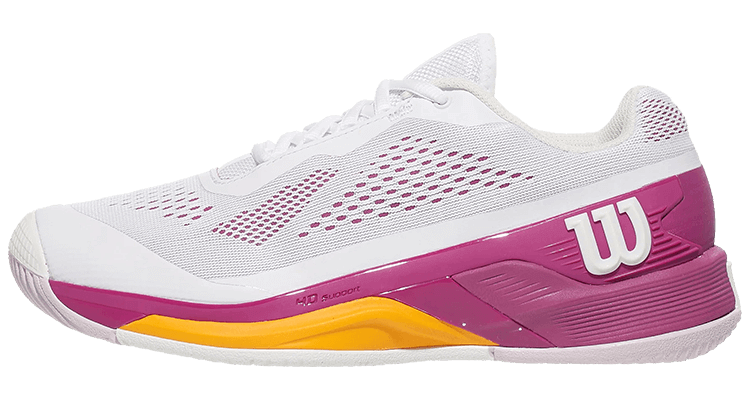
The Rush Pro 4.0 is Wilson’s latest iteration of their flagship all-court tennis shoe, offering comfort and durability.
The shoe’s outsole uses Duralast, a high-density and durable rubber compound that resists abrasion and provides players excellent traction on all court surfaces. Baked into the midsole, you’ll also find Wilson’s 4D Support Chassis 2.0, which optimizes support, acceleration, stability, and control for precise movement.
Wilson uses a highly compressed and proprietary EVA foam called R-DST+ at the shoe’s midsole to deliver excellent cushion without adding significant weight or bulk while maintaining a responsive feel. Wilson layers an Ortholite EVA molded sock liner on top of the midsole for additional comfort and moisture control.
The Wilson Rush Pro 4.0 features a minimalistic layered upper dubbed Sensifeel 2.0 that incorporates mesh for maximum comfort and ventilation. The shoe also includes a Drag Pad on the inside or medial portion toward the front for drag protection. Finally, the inner Endofit sock construction helps ensure comfort and a locked-in feel.
Why I Love Them
- Comfort
- Stability
Area for Improvement
- Traction
Specs
| Size | True |
| Width | Medium |
| Arch Support | Low |
| Weight | 11.8 ounces @ size 8.5 |
| Colors | White/Baton Rouge Black/White/Blue Blue/White/Coral White/Pearl Blue |
Ratings
Asics Solution Speed FF 2
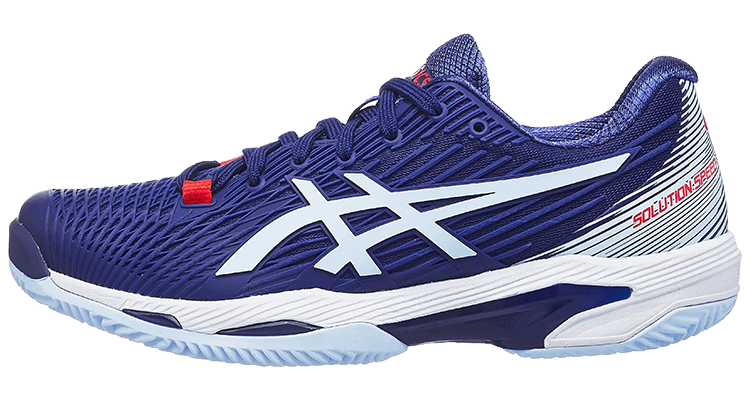
The Asics Solution Speed FF 2 is one of the best women’s tennis shoes that offers all-around performance in a lightweight package.
The outsole features a high abrasion rubber dubbed AHAR to provide excellent traction and an all-court tread. The shoe also receives added protection at the front with a prominent toe guard.
At the midsole, you’ll find Asics’ FlyteFoam cushioning (one of the key upgrades from the prior model), which offers 76 percent better cushioning while shedding 55 percent of the weight in your typical midsole. The latest model also extends the Twistruss shank for added stability.
The Asics Solution Speed FF 2 also features a comfortable single-piece upper covered in Dynawrap, a durable polyurethane rubber that provides a protective coating around the entire shoe.
All in all, this is a popular lightweight shoe that’s worth checking out.
Why I Love Them
- Lightweight comfort
- Traction
Area for Improvement
- Ventilation
Top Players Using
- Daria Gavrilova
- Julia Goerges
- Daria Gavrilova
- Monica Puig
- Jennifer Brady
Specs
| Size | True |
| Width | Medium |
| Arch Support | Medium |
| Weight | 10.6 ounces @ size 8.5 |
| Colors | White/Amethyst Dive Blue/Sky White/Frosted Rose Blue/Indigo Purple/Blue White/Peacoat Black/White White/Black Peacoat/Rose |
Ratings
New Balance 996 v5

The New Balance 996 v5 is a lightweight women’s tennis shoe with excellent all-court performance.
For the outsole, you’ll find NDurance rubber used sparingly for maximum durability to keep the shoe lighter than its competitors.
For comfort, the midsole puts New Balance’s FuelCell foam to use throughout the entire length of the shoe for the highest level of energy return – a responsive feel you’ll love.
Keeping with the New Balance 996 v4’s minimalist theme, the upper’s Hypoknit construction offers lightweight breathability and support. For added protection up front, you’ll find a layer of NDure polyurethane protection above the toes.
This one is worth checking out if you’re looking for a lightweight tennis shoe.
Why I Love Them
- Comfort
- Traction
Area for Improvement
- Durability
Top Players Using
- Caroline Garcia
Specs
| Size | True |
| Width | Wide |
| Arch Support | Low |
| Weight | 10.8 ounces @ size 8.5 |
| Colors | Dragonfly/White |
Ratings
Asics Gel Resolution 9

The Asics Gel Resolution 9 offers terrific all-around performance that’s stable, comfortable, and durable.
The shoe’s outsole consists of AHAR+ that delivers abrasion resistance three times greater than traditional rubber and a prominent tread pattern for performance on any court surface.
For the midsole, you’ll find Asics’ Gel cushioning to help reduce shock, which feels great at the heel and ball of your foot. FlyteFoam, throughout the length of the shoe, provides all-over comfort and performance.
At the sides and heel of the shoe, Dynawall technology helps give the shoe added structure to help players maintain stability, especially during lateral or side-to-side movements.
The Gel Resolution 9’s upper features glove-like comfort with Dynafit, which is more flexible and forgiving than the previous version. Asics has also updated its Dynawrap technology in the eyelets for added stability, and the upper continues to feature a durable polyurethane protective cover, helping to make it one of the most durable offerings on the market.
Why I Love Them
- Comfort
- Stability
Area for Improvement
- Ventilation
Top Players Using
- Johanna Konta
- Caroline Garcia
- Samanta Stosur
- Monica Niculescu
- Iga Swiatek
- Leylah Fernandez
- Coco Vandeweghe
Specs
| Size | True |
| Width | Snug Medium |
| Arch Support | Low |
| Weight | 12.7 ounces @ size 8.5 |
| Colors | White/Amethyst White/Silver |
Ratings
Nike Zoom Vapor 11
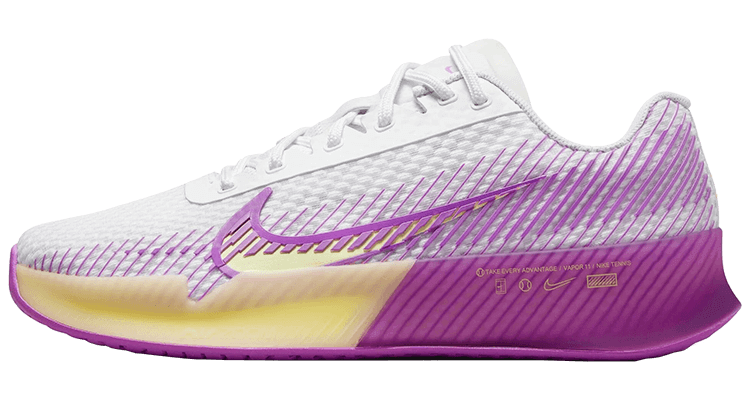
The Nike Zoom Vapor remains one of the market’s most popular tennis shoes on the men’s and women’s sides.
The shoe’s outsole is minimalistic compared to other tennis shoes, which helps lower the shoe’s weight. Nike adds and subtracts where players experience high or lower areas of wear.
The Vapor 11’s midsole includes a slim Zoom Air unit at the shoe’s front for lightweight, low-profile, responsive comfort that keeps players connected with the court. The remainder of the midsole provides comfort with a light and responsive EVA foam to complete the package.
The most significant change for the Nike Zoom Vapor 11 comes with the redesigned upper that combines a half bootie construction with mesh for lightweight and breathable comfort. Plus, an asymmetrical lacing system hugs your foot for added stability.
Why I Love Them
- Responsive comfort
- Stability
Area for Improvement
- Durability
Top Players Using
- Garbine Muguruza
- Andrea Petkovic
- Angelique Kerber
- Caroline Wozniacki
- Jelena Ostapenko
- Qiang Wang
Specs
| Size | True |
| Width | Coming Soon |
| Arch Support | Coming Soon |
| Weight | Coming Soon @ size 8.5 |
| Colors | Black/White White/Silver White/Citron/Fuchsia |
Ratings
Fila Axilus 2.5 Energized

Rounding my list of the ten best women’s tennis shoes is the durable and lightweight Fila Axilus 2.5.
The shoe puts Fila’s Evergrind two-piece rubber outsole to work for durable traction with a familiar tread pattern, which is thicker on the inside and narrower on the inside to aid sliding.
The shoe’s midsole provides players with comfort by incorporating Energized Rubber to absorb shock while offering plenty of response, and a midfoot shank adds stability and prevents twisting.
The upper of the Fila Axilus 2.5 is a breathable mesh with a protective outer cage that molds to the shoe and increases its stability.
Why I Love Them
- Stability
- Traction
Area for Improvement
- Durability
Top Players Using
- Ashleigh Barty
- Kiki Bertens
- Sofia Kenin
- Shelby Rogers
- Karolina Pliskova
Specs
| Size | True |
| Width | Wide |
| Arch Support | Low |
| Weight | 11 ounces @ size 8.5 |
| Colors | White Black Blue White/Pink Blue/Green |
Ratings
K-Swiss Ultrashot 3

The K-Swiss Ultrashot 3 is a welcome revision to the previous generation, offering top-notch durability and respectable stability.
The shoe’s outsole features a durable Draggaurd 7.0 rubber that resists abrasion and protects the toe and heel while delivering excellent traction with a dense herringbone tread pattern.
The shoe uses Surge 7.0 cushioning for the midsole, which delivers lightweight comfort, and a 360 PCS midfoot shank that helps ensure maximum support and stability.
The Ultrashot 2 uses a lightweight mesh upper to keep the shoe well-ventilated and layers it with SlideGaurd along the outside of the shoe to enhance durability during slides.
Finally, the shoe features a DuraWrap molded rubber overlay on the inside edge for drag protection.
Why I Love Them
- Durability
- Traction
Area for Improvement
- Ventilation
Top Players Using
- Ajla Tomljanovic
- Venus Williams
Specs
| Size | True |
| Width | Medium |
| Arch Support | Medium |
| Weight | 12.3 ounces @ size 8.5 |
| Colors | White/Blue Nectar/Pink Pink/Sapphire Asphalt/Amber |
Ratings
adidas Adizero Ubersonic 4
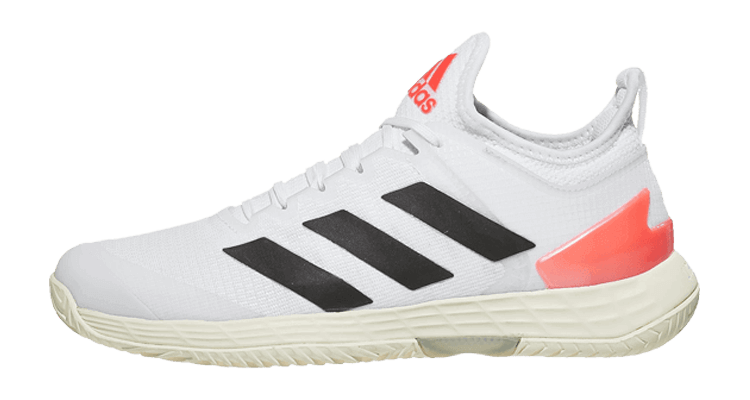
The adidas Adizero Ubersonic 4 is a comfortable option with excellent breathability and all-around performance.
The outsole of this pair of shoes uses one of my favorite, Adiwear, which provides excellent traction. New to this generation is a tighter tread on the inside portion for extra durability and a wider tread toward the outside for easier sliding.
adidas now features their updated Lightstrike cushioning system at the midsole for maximum comfort without giving up that responsive feel for optimal movement.
The Primeknit bootie is a seamless fabric that’s lightweight and breathable, forming the upper. Over the top, adidas adds Primegreen material for extra stability and abrasion resistance. Then, strategically placed around the shoe’s upper, Adituff provides additional abrasion-resistant material for protection.
The result is a well-rounded shoe that offers terrific performance across the board.
Why I Love Them
- Comfort
- Traction
Area for Improvement
- Durability
Top Players Using
- Kristina Mladenovic
Specs
| Size | True |
| Width | Medium |
| Arch Support | Medium |
| Weight | 11.6 ounces @ size 8.5 |
| Colors | White/Violet Grey/Violet White/Orange/Lilac White/Silver/Cyan Almost Yellow Carbon/Blue White/Orange White/Silver |
Ratings
Asics Court FF 3
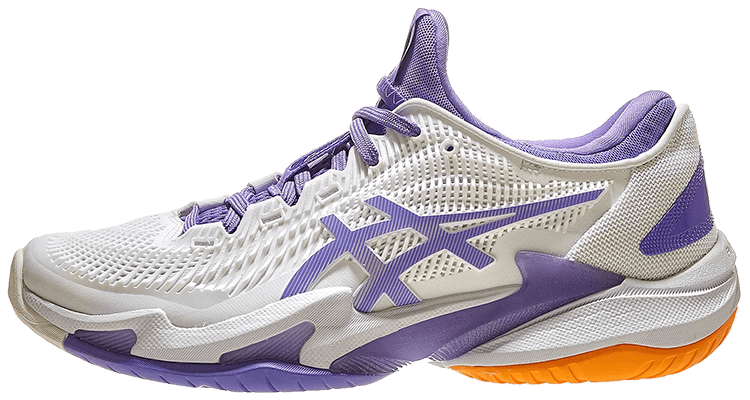
The Court FF 3 is a high-performance offering from Asics that delivers a well-rounded performance with few downsides.
The shoe uses an AHAR+ rubber outsole that delivers excellent traction and significantly better abrasion resistance and durability than standard rubber. As a bonus, the outsole wraps up the shoe’s inside edge and further up the toe than most for extra protection.
The midsole for the Asics Court FF 3 takes advantage of FlyteFoam for exceptional lightweight comfort, while gel cushioning at the heel and forefoot helps absorb shock, especially on hard courts. A midfoot Twisstruss shank helps reduce twisting and aids side-to-side stability.
The shoe’s upper has a mono-sock construction for a glove-like fit that adds to the shoe’s stability, along with a durable outer PU cover that helps resist abrasion while further adding support.
Overall, the Asics Court FF 2 doesn’t disappoint in many areas except ventilation, where the shoe could improve breathability.
Why I Love Them
- Stability
- Durability
Area for Improvement
- Ventilation
Specs
| Size | True |
| Width | Medium |
| Arch Support | Medium |
| Weight | 12.9 ounces @ size 8.5 |
| Colors | Green/Reborn Blue White/Amethyst White/Silver White/Lapis Lazuli BLue |
Ratings
adidas adizero Cybersonic
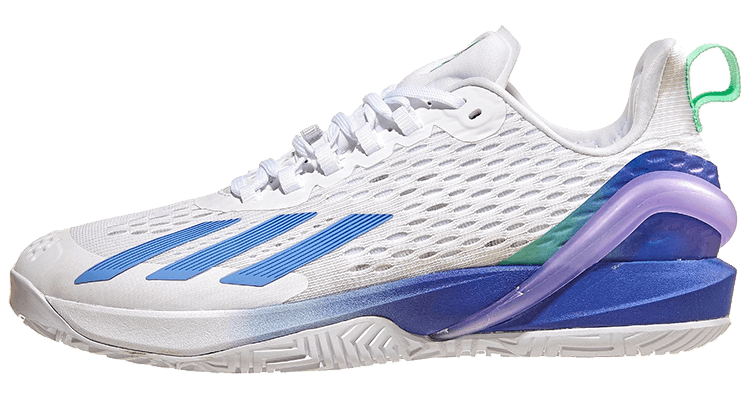
The adizero Cybersonic is the latest edition of adidas’ tennis shoe lineup, offering lightweight comfort and stability.
You’ll find the sports giant’s tried and true adiwear rubber compound for the outsole in a distinct geometric tread pattern for excellent traction that suits hard courts.
The midsole integrates a Dual Density Ligthstrike EVA foam that provides optimal cushion and shock absorption, combined with Energy Rods, which wrap the heel and extend throughout the shoe to enhance stability and support while improving your acceleration for maximum speed.
For the upper, the adizero Cybersonic features breathable mesh along with a bootie construction for a glove-like fit. Layered on top of the upper, you’ll find an Aditff toe cap that extends through the inside or medial edge to help protect against foot drags.
Why I Love Them
- Lightweight comfort
- Stability
Area for Improvement
- Durability
Specs
| Size | True |
| Width | Snug Medium |
| Arch Support | Medium |
| Weight | 11.8 ounces @ size 8.5 |
| Colors | White/Blue/Mint |
Ratings
New Balance Lav v2
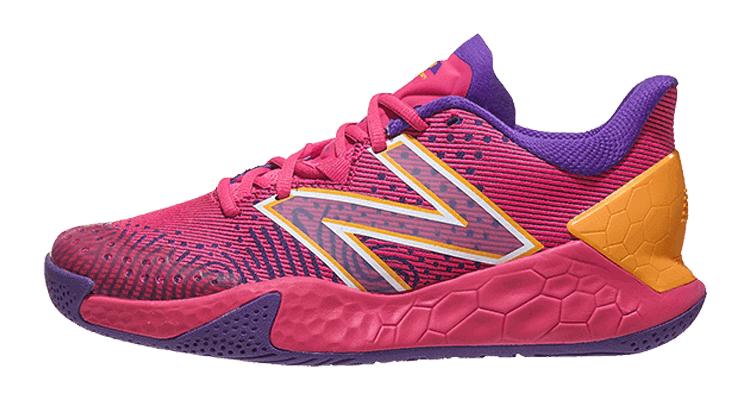
The New Balance Lav v2 is a fresh take on the original version, which delivered stability and durability.
The latest generation features New Balance’s Ndurance outsole for reliable traction and durability while helping keep the shoe’s weight down.
Fresh FoamX provides players with extra cushioning at the midsole through a data-influenced design that helps optimize comfort.
Finally, a lightweight mesh FitWeave upper allows for flexible comfort without giving up support for stability.
Aggressive movers will appreciate their durability and stability but should be aware of their slightly stiffer feel and lower ventilation.
Why I Love Them
- Comfort
- Stability
Area for Improvement
- Durability
Specs
| Size | True |
| Width | Medium |
| Arch Support | Low |
| Weight | 12 ounces @ size 8.5 |
| Colors | Egg Yolk/Red White/Pink Yellow White/Blue |
Ratings
Babolat Jet Mach III

A lightweight performance shoe from Babolat, the Jet Mach III is a solid all-around performer ideal for speed and agility.
The Jet Mach III features a high-quality premium DIN20 rubber outsole from Michelin that’s highly durable and ideal for hard courts.
For a soft ride, the midsole incorporates KPRS-X foam for impact-resistant comfort, especially at the heel, which is 1 mm thicker than the prior model.
Finally, the shoe is topped with MATRYX EVO Aramid and Polyamid fibers for stability and support while retaining sufficient flex for comfort.
Our favorite part about the Jet Mach III is that it doesn’t suffer too much in terms of stability and durability despite its lighter weight, a common problem among similar lightweight offerings.
Why I Love Them
- Durability
- Traction
Area for Improvement
- Ventilation
Specs
| Size | True |
| Width | Medium |
| Arch Support | Medium |
| Weight | 10.2 ounces @ size 8.5 |
| Colors | White Pink/Black Pink/Blue |
Ratings
adidas Barricade
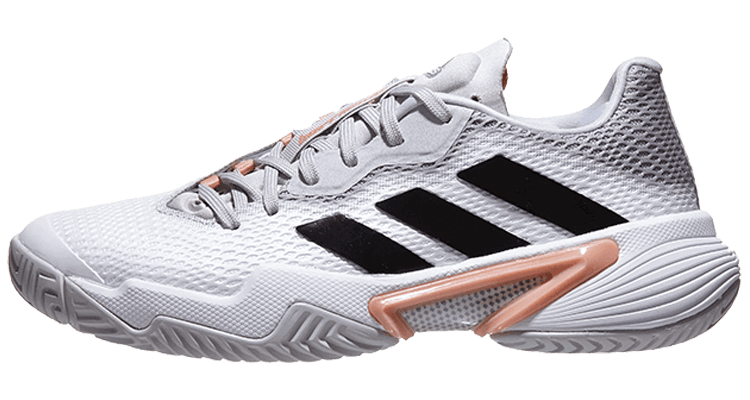
In 2018, adidas took a break from producing their Barricade line of tennis shoes, but in 2021 they returned with an all-new update. Although the shoe pays tribute to its predecessors, the 12th generation is a complete rebuild of the shoe.
For the outsole, players will find adidas’ ultra-reliable Adiwear rubber outsole split into two pieces by a midfoot shank that aids stability. The tread is thicker on the inside edge for added durability, while the outside portion helps maximize grip.
The Barricades midsole incorporates Bounce 2.0 for responsive comfort that’s lightweight and impact-resistant.
Finally, the shoe’s upper has a neoprene tongue for breathable comfort, an asymmetrical lacing system for a locked-in fit, and an abrasion-resistant outer layer to improve durability. adidas tucks away the lacing eyelets on the inside edge to help reduce wear to the shoelaces.
Although the shoe excels in the stability and durability departments, its extra weight and lower comfort are well worth considering when evaluating this shoe.
Why I Love Them
- Stability
- Durability
Area for Improvement
- Comfort
Top Players Using
- Maria Sakkari
- Qiang Wang
Specs
| Size | True |
| Width | Medium |
| Arch Support | Medium |
| Weight | 12.5 ounces @ size 8.5 |
| Colors | Blue/Violet/Mint White/Silver/Bright Cyan Grey/Orange/Pink Orange/Solar Orange Green/White White/Blue Rose/Black/Purple White/Silver/Red |
Ratings
Durability Guarantees

With most people playing tennis on hard courts, one of the most common knocks on tennis shoes is their lack of durability.
Frequently, players are frustrated when their shoes only last a few months, and it can become expensive to replace them continually. As a result, many retailers and shoe brands will offer durability guarantees for specific models to help instill confidence in buying a new pair.
Typically, a guarantee will be valid for a set period, i.e., six months, and only for the shoe’s outsole.
If you buy a shoe with a similar guarantee, keep in mind that there are guidelines for replacement, which tend to be strict. Often, a player must wear entirely through the outsole for a valid claim.
In my opinion, it’s a double-edged sword. It’s great that you can request to have your shoes replaced if you wear through the sole that quickly. However, if you’re still playing with a shoe that’s anywhere near wearing through the outsole, it’s less than ideal and can be dangerous because it means you have significantly less traction.
Last but not least, you’ll have to return your shoes to qualify for a replacement. If you don’t own more than one pair, you may be stuck not playing tennis until they send a replacement.
Wrapping Up
Whether you’re just learning to play tennis or an experienced player with years of experience, finding a pair of tennis shoes you enjoy is critical for your feet and body’s health.
As you shop for the best pair for your needs, it can help set a budget ahead of time and determine which features, i.e., comfort, durability, stability, etc., are most important to narrow your options.
Hopefully, my guide helps shed some light on how to think about buying a pair of tennis shoes while at the same time focusing your search on a tight selection of shoes you can feel confident in purchasing.
Of course, if you have any questions or have a pair of tennis shoes you can’t live without, I’d love to hear from you in the comments.
Play Better Tennis
Improve your game alongside our community of tennis players
Why join?
Discussion Boards
Join the conversation with other members of the community.
5 Point Friday
Read our weekly recap of the 5 most interesting things we dig up in tennis.

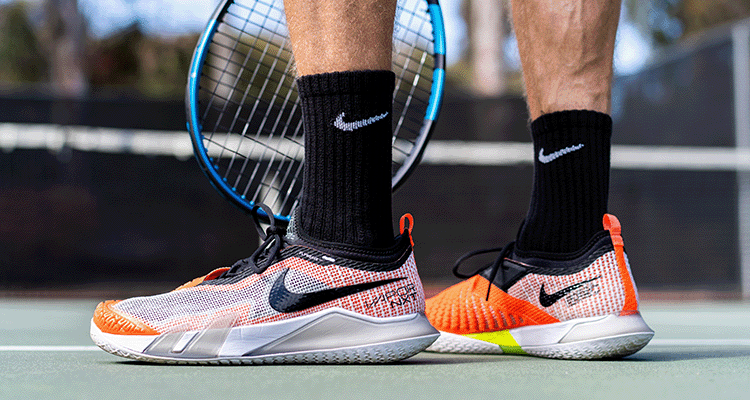

Leave a Reply
Want to join the discussion?Feel free to contribute!